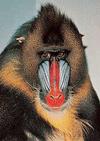- mandrill
-
/man"dril/, n.a large baboon, Mandrillus (or Papio) sphinx, of western Africa, the male of which has a face brightly marked with blue and scarlet and a muzzle that is ribbed: an endangered species.[1735-45; MAN1 + DRILL4]
* * *
Diurnal monkey (family Cercopithecidae, usually genus Mandrillus) of equatorial African rainforests, known for its striking colouring.The stout-bodied, primarily terrestrial mandrill has a short tail, prominent brow ridges, and small, close-set, sunken eyes. The ribbed bare skin on the adult male's cheeks is bright blue, with scarlet on the nose; the buttock pads are pink to crimson, shading to bluish; and the beard and neck are yellow. The adult male is about 3 ft (90 cm) long and weighs about 45 lb (20 kg); the female is duller and smaller. Mandrills eat fruit, roots, insects, and small reptiles and amphibians. Mandrill (Mandrillus sphinx).Russ Kinne/Photo Researchers
Mandrill (Mandrillus sphinx).Russ Kinne/Photo Researchers* * *
▪ primatecolourful and primarily ground-dwelling monkey that inhabits the rainforests of equatorial Africa from the Sanaga River (Cameroon) southward to the Congo River. The mandrill is stout-bodied and has a short tail, prominent brow ridges, and small, close-set, sunken eyes. The adult male has bare coloured patches of skin on both the face and the buttocks. On the face, the cheeks are ribbed and range in colour from bright blue to violet, with scarlet along the bridge and end of the nose. The buttock pads are pink to crimson, shading to bluish at the sides. The long body fur is olive to brown, and the small beard and the neck fur are yellow; the eyes are framed in black. The adult male is about 90 cm (3 feet) long, including the tail stub, and weighs up to 35 kg (77 pounds), which makes it the largest of all Old World monkeys. The female, also with bare face and buttocks, is duller in colour and considerably smaller, only about 13 kg on average. Like baboons (baboon), females develop swellings on their hindquarters when they are in estrus.Mandrills feed on fruit, roots, insects, and small reptiles and amphibians. They live in troops consisting of a male and several (occasionally up to 20) females along with their young. At times several troops come together and travel in enormous aggregations of 100 or more. They are threatened by deforestation of their habitat for agriculture and lumbering as well as by hunting; their flesh is considered to be delicious and fetches high prices in local markets.The mandrill, along with the related drill, were formerly grouped as baboons in the genus Papio. Both are now classified as genus Mandrillus, but all belong to the Old World monkey family, Cercopithecidae.* * *
Universalium. 2010.
